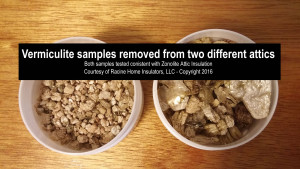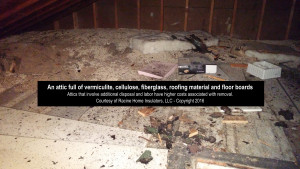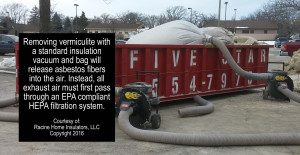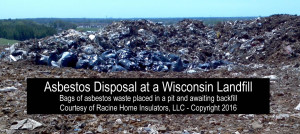1) What does it look like and how common is vermiculite attic insulation and the Zonolite brand of vermiculite insulation?
Answer: From the early 1900s to the 1980s vermiculite was one of the only forms of insulation available and it was easily installed by contractors and homeowners alike by pouring it out of a bag. With large processing plants in both Milwaukee and Kenosha that received the raw vermiculite mineral by railroad from Libby, Montana, vermiculite attic insulation is estimated to be in thousands 0f homes in southeast Wisconsin.
Vermiculite sold under the brand name “Zonolite” was used well into the 1980s. Over 80% of the vermiculite installed in southeast Wisconsin is believed to be Zonolite brand attic insulation (ZAI). One of our nation’s largest environmental and health disasters, Libby, Montana is one of the EPA’s largest superfund sites.
This is a photo of what typical vermiculite looks like. On the left is fine granulated vermiculite from the 1960s through 1980s. On the right is coarse granulated vermiculite from 1920s through 1960s. Click the image to view it in full size.
2) How much does it cost to remove vermiculite from an attic?
Answer: After reimbursement from the ZAI Trust, the net cost to the homeowner can be as low as $1.50/sq-ft.
Removal costs are lowest when there is only 2-3″ of pure vermiculite (Zonolite) in an attic with easy access and a high peak. When vermiculite is 6-8″ deep the cost to remove increases.
In this picture, the vermiculite is in contact with both fiberglass and cellulose, and these materials must also be treated as contaminated. There is also roofing material and other debris that will need to be removed. Click the image to view it in full size.
3) Can vermiculite be sucked out of an attic using a traditional attic insulation vacuum and vacuum bags?
Answer: No. Companies that do this are creating a health hazard for their employees, homeowners, and the neighborhood.
Attic vacuums emit several thousand cubic feet of air per minute and attic vacuum bags trap only the large cellulose and fiberglass particles. Asbestos fibers will easily pass through the vacuum bags and become airborne, creating a serious health hazard. Don’t let someone remove vermiculite from your attic like it is cellulose or fiberglass. Click the image to view it in full size. (Note: this image shows loose fill fiberglass being removed from an attic – it is not vermiculite).
As homeowner you are the “generator” of the hazardous waste, and you can be liable if it causes a health hazard or is disposed of improperly. To be safe, and to comply with the law, all exhaust from an attic vacuum must be “scrubbed” with HEPA filters before being released into the environment. Before you hire an asbestos contractor be sure to ask the proper questions and obtain the proper documents. Read more at our Contractor Checklist page.
4) Can vermiculite be disposed of at the local landfill?
Only if the landfill has a permit to accept asbestos (vermiculite) and the company bringing the asbestos has been approved by the landfill for a “Special Waste Profile”. Landfills are regulated by the Department of Natural Resources, and all asbestos containing materials, including vermiculite, have to be handled in a manner different than regular waste. In order to dump vermiculite and other asbestos containing materials a “Special Waste Profile” is required.
Contractors that attempt to dispose of vermiculite without informing the landfill what they are dumping run the risk of serious fines from the DNR as well as paying for the cost of clean-up. When waste is dumped illegally at a landfill the “generator” of the waste, or homeowner, can be held responsible. Homeowners must make sure they only hire contractors that carry “pollution liability” insurance and have established a “Special waste profile” with their landfill. Click the image to view it in full size.
5) Is the contractor who is hired to remove or disturb the vermiculite required to notify the Wisconsin Department of Health Services (DHS) before they begin work?
Answer: Yes. The Wisconsin Department of Health Services (DHS) considers vermiculite a material that is suspected to contain asbestos. Other suspect materials are plaster, asphalt shingles, and floor tiles. These other suspect materials can first be tested for the presence of asbestos, but not vermiculite. The EPA has determined that there is no reliable test for the presence of asbestos in vermiculite and it remains a suspect material. As a result, anyone disturbing or removing vermiculite is required to notify DHS prior to disturbing or removing it. This offers protection to both the workers and the homeowner as DHS can then stop by unannounced and check for proper licensing and work practices of the licensed asbestos abatement company. This picture shows the notification paperwork that must be posted in clear view on site when performing removal of vermiculite insulation.
6) I have determined my attic has vermiculite insulation. Should I remove it?
Answer: Every homeowner will have to decide for themselves, but because the ZAI Trust will reimburse 55% of the cost of professional removal and re-insulation it is now a safe and wise investment. Keep in mind the insulation must be found to be consistent with Zonolite attic insulation in order to be eligible for the 55% reimbursement. There are three primary reasons for moving ahead with removal.
- The presence of vermiculite greatly reduces the value of your home. There is no reliable test to determine if the vermiculite in your attic contains asbestos, so don’t waste your money on a test others will deam meaningless. Regardless of what the owner/seller thinks, anyone purchasing a home with vermiculite insulation is overpaying unless the full cost of professional removal and re-insulation of the vermiculite insulation has been deducted from the price, or agreed to be paid by the seller.
- The presence of vermiculite is a health hazard and should never be disturbed. Most vermiculite attic insulation is Zonolite brand insulation and contains asbestos. As a result, the occupants and workers are at risk, especially if the insulation is disturbed for any reason. Common reasons for disturbing attic vermiculite are:
- attic rewiring
- installing recessed can lights or speakers
- venting bathroom and kitchen exhaust fans
- air sealing and insulating an attic by homeowner or insulation contractor
- planned renovations such as kitchens and bathrooms
- deep renovations on foreclosures and homes being “flipped” by renovators
- rodent, mice, and bat infestation
- unplanned repairs caused by water or fire damage.
- The money under control by the ZAI Trust will not be around forever. Once the money is gone the program ends.
- Deferment from low income weatherization programs. Homeowners and/or tenants that qualify for free insulation and heating improvements through Wisconsin’s weatherization programs are immediately deferred (denied) when vermiculite is present in the attic or walls. Having the vermiculite removed will allow the free services to be installed as long as documentation is provided that shows the removal was done by a licensed and reputable asbestos abatement company.
- If you need more insulation and you let someone add insulation on top of your existing vermiculite, you will likely end up paying to have that removed as well when the time comes to sell your home. Some contractors, and some weatherization programs, try to explain that they can “work around” vermiculite. This is bad advice because it is not possible to properly air seal and/or insulate an attic without disturbing the vermiculite.In fact, blowing cellulose or fiberglass over the top simply disturbs the vermiculite and likely causes the smallest fibers (asbestos) to become airborne. It is impossible to encapsulate vermiculite by covering it with another loose blown insulation. And once this additional insulation has come in contact with vermiculite it must now also be considered contaminated. As a result the removal costs may now have doubled, and the property has further depreciated in value.Low income weatherization programs that try to first cover the vermiculite with a house wrap are doing no favors to the owner. First, they would still need to air seal the attic plane and that can’t be done without disturbing the vermiculite wherever there is a wall top plate, light fixture, exhaust fan, wire penetration, chimney, and plumbing vent. In order to do that you must be an asbestos abatement contractor. Second, the removal costs are now even higher than that described in #5 above.




